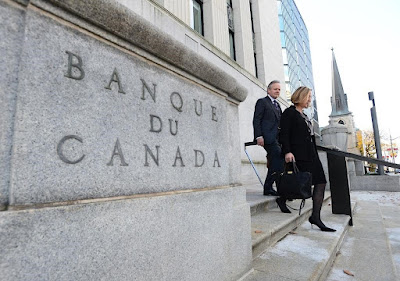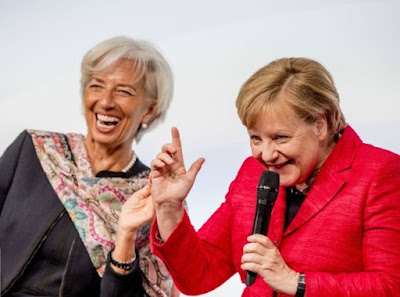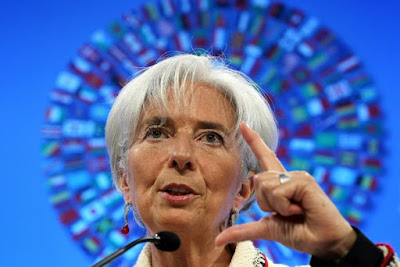Overview: The US dollar continues to pare its recent losses and is firm against most major currencies in what has the feel of a risk-off day. The other funding currencies, yen and Swiss franc, are steady, while the euro is heavy but holding up better than the Scandis and dollar-bloc currencies. Emerging market currencies are also lower, and the JP Morgan EM FX index is off for the third consecutive session. The Chinese yuan’s insignificant gain of less than 0.15% puts it on the top of the emerging market currency complex. After rising nearly five basis points yesterday, the US 10-year yield has come back a couple of basis points softer at 1.35%, while European yields are narrowly mixed. Asia Pacific yields rose in what looked like a catch-up move.
Topics:
Marc Chandler considers the following as important: 4.) Marc to Market, 4) FX Trends, Bank of Canada, Currency Movement, ECB, Featured, Japan, newsletter, U.K., USD
This could be interesting, too:
Nachrichten Ticker - www.finanzen.ch writes Die Performance der Kryptowährungen in KW 9: Das hat sich bei Bitcoin, Ether & Co. getan
Nachrichten Ticker - www.finanzen.ch writes Wer verbirgt sich hinter der Ethereum-Technologie?
Martin Hartmann writes Eine Analyse nach den Lehren von Milton Friedman
Marc Chandler writes March 2025 Monthly
Overview: The US dollar continues to pare its recent losses and is firm against most major currencies in what has the feel of a risk-off day. The other funding currencies, yen and Swiss franc, are steady, while the euro is heavy but holding up better than the Scandis and dollar-bloc currencies. Emerging market currencies are also lower, and the JP Morgan EM FX index is off for the third consecutive session. The Chinese yuan’s insignificant gain of less than 0.15% puts it on the top of the emerging market currency complex. After rising nearly five basis points yesterday, the US 10-year yield has come back a couple of basis points softer at 1.35%, while European yields are narrowly mixed. Asia Pacific yields rose in what looked like a catch-up move. Although Japan’s Topix set a new 31-year high today, the MSCI Asia Pacific Index snapped an eight-day advance today. It has risen 11 of the past 12 sessions, during which time it rose nearly 9%. The Dow Jones Stoxx 600 is off for a second day, and the 1% loss it is nursing near midday in Europe, is its largest loss in nearly three weeks. US futures point to a heavy opening after yesterday’s losses by the S&P 500 and Dow Industrials. Gold is consolidating near yesterday’s trough. It fell 1.6% yesterday, the biggest drop in a month, and is struggling to re-establish a foothold above $1800. Oil is also steadying today. October WTI fell by about 2.4% since the US employment report. It is trading a little above $69.00 near midday in Europe. Today, China’s iron ore futures contract rose about 0.5% to end a six-day, 12% slide. Copper is heavy for a second session. It fell 1.1% yesterday and is down a little more today. The CRB Index fell 1% yesterday, its biggest loss in two weeks.
Asia Pacific
Japan’s Q2 GDP was revised higher. The quarterly rate increased to 0.5% from 0.3%, and the annualized rate rose to 1.9% from 1.3%. The upward revision was more than expected and largely resulted from more government spending (1.3% vs. 0.5%) and capex (2.3% vs.1.7%). Consumption rose by 0.9% rather than 0.8%. Inventories and net exports each took 0.3% from GDP. And frustratingly, the GDP deflator was revised to -1.1% from -0.7%, leaving this measure of deflation at its strongest pace in a decade. Meanwhile, regardless of the outcome of the LDP leadership contest later this month, a substantial fiscal package will be unveiled. Such expectations appear to be helping lift Japanese stocks. The Topix is at levels not seen in 30 years, and the Nikkei is up over 6% in the past five sessions.
China is expected to report CPI and PPI figures tomorrow. Both are expected to have held steady at 1.0% and 9.0%, respectively. China has auctioned some of its strategic holdings of industrial metals to end-users to help ease the pressure on prices. However, the mild CPI pressure gives the PBOC room to ease financial conditions in the face of an economy that is struggling to sustain forward momentum.
The dollar rose to JPY110.45 in early Asia, its highest level since August 13 was reversed lower and looks poised to test the JPY110 level where an option for about $780 mln expires later today. The bottom of the large triangle pattern being traced comes in today near JPY109.70. With a couple of minor exceptions, the greenback has been in a JPY109-JPY111 trading range for two months. The Australian dollar peaked last Friday, on the back of the disappointing US jobs growth, near $0.7480. Its third consecutive decline today has brought it to about $0.7350. The $0.7335 area corresponds to a (38.2%) retracement objective of the bounce from nearly $0.7100 on August 20. The 20-day moving average and next retracement target (50%) are found around $0.7300. The Chinese yuan edged higher for the first time this week. Recall that coming into this week, the yuan had risen for six sessions in a row. The dollar remains in the lower end of the CNY6.45-CNY6.50 range that has dominated for three months. The PBOC set the dollar’s reference rate at CNY6.4674 compared with the median expectation in Bloomberg’s survey for CNY6.4669. The researchers at the PBOC seemed to play down market speculation of another cut in the reserve requirements saying that that macro leverage ratio is likely to remain “basically stable” in H2. The 10-year government bond yield rose a couple of basis points.
Europe
This week’s focus is on tomorrow’s ECB meeting. The issue that has captured many market participants’ imagination is what it signals about the pace of its bond-buying as if it were really the key to the euro or interest rates. The transmission mechanism of asset purchases to currency and interest rates is far from precise. Indeed, even if one knew in advance how much the Eurosystem was buying in a given month, one would still be hard-pressed to forecast the exchange rate or interest rates based on it. Note that due to lower supply and thinner markets, the ECB slowed its bond-buying in August to around 65 bln euro from the 80 bln average in Q2. Also, if the ECB does formally slow its purchase, this is different than the tapering that the US will implement and that the Bank of Canada has already implemented, which kind of tapering is to gradually reduce the pace of buying to avoid a sudden stop. The ECB’s “tapering” represents a modest variation in pace within fairly narrow bounds.
Eurozone economic data today included France’s Q2 payrolls (stronger than expected) and the July trade/current account deficit (larger than expected). Italy’s July retail sales disappointed. After jumping by 0.7% in July, they had been expected to pull back, but the 0.4% decline was twice as large as anticipated. Germany reports its July trade figures tomorrow. Its trade surplus averaged 16.1 bln euro a month in H1 21 compared with a 12.8 bln euro average surplus in H1 20 and 18.3 bln average in H1 19.
It appears that the UK Prime Minister has put down a backbench rebellion against the breaking of campaign promises not to raise major taxes and commitment (triple-lock) on pensions. Of course, as Johnson says taxes were not in the election manifesto neither was Covid. Fair enough, but the issue may not be so much about tax increases, but which taxes. The national health insurance levy is not progressive. Still, the government made some effort to minimize the regressive element by excluding incomes of less than GBP9500 a year from the tax and to tax dividends.
The euro ended a six-day rally with a three day-decline. It settled near $1.1880 last week after the US jobs report and approached $1.1815 today, meeting the (38.2%) retracement objective of the rally since the August 20th low near $1.1665. The (50%) retracement is by $1.1785, which also corresponds to the 20-day moving average. The next retracement (61.8%) is roughly $1.1760. There is an option for about 690 mln euros at $1.1800 that expires today. Sterling is also off for the third consecutive session. It has met the (50%) retracement objective of its rally from the August 20 low (~$1.36) at today’s low near $1.3750. The next retracement (61.8%) is closer to $1.3715. The euro continues to hover around GBP0.8600, a cap it has not been able to close above since July 20.
America
The US reports weekly mortgage applications, July JOLTS, the Fed’s Beige Book, and July consumer credit. Job openings outstrip the number of unemployed. The Beige Book is the anecdotal summary of economic conditions ahead of the FOMC meeting. It seems clear from high-frequency data that the economy has softened in recent weeks. Consumer credit is not a market mover, but it is an important part of consumption. Recall that in Q2, consumer credit (not including mortgages) rose by a record $93.3 bln. To put that in perspective, it is more than consumer credit expanded in H2 19. Consumer credit rose by almost $40 in Q1 21. As an aside, news that the last of the old partnership banks in the US (Brown Brothers Harriman) was selling its asset manager services (including custody, foreign exchange, securities lending, etc.) seems to be among the bearish takes about the asset markets themselves. The business had been built over the past few decades, and it benefits rising assets under the management of its clients. The sales of its investor service seem to signal a less optimistic outlook going forward. Of course, other considerations, such as the investment needed to maintain the economy of scale required, may have also played a role.
The North American highlight today is the Bank of Canada meeting. The central bank has already reduced its weekly bond purchases from C$5 bln a week this time last year to C$2 bln now. The economy unexpectedly shrank by 1.1% in Q2. In July, the central bank had forecast a 2.5% expansion, and its preliminary forecast, subject to revision, anticipated a contraction at the start of Q3. One need not know there was a national election in a couple of weeks to anticipate that the Bank of Canada will stand pat today. Governor Macklem delivers a speech on Thursday, “Quantitative Easing and the Reinvestment Phase.” We do not think it is a tell of what to expect today. Clearly, the reinvestment phase is next, but it does not mean imminent. The challenge that central banks face seems to be normalizing the use of their balance sheet. The Bank of Canada projected that the output gap will likely close around the middle of next year. This still seems to be a fair assessment and why the market still favors a hike around then.
The US dollar bottomed at the end of last week against the Canadian dollar slightly below CAD1.25. Today is the third successive advancing session, and it poked above CAD1.27 in Europe. The CAD1.2720 area corresponds to the (50%) retracement of the greenback’s decline from the August 20 high near CAD1.2950. The next retracement target (61.8%) is closer to CAD1.2775. If the Canadian dollar recovers after the Bank of Canada statement, a test on CAD1.2640, where a $900 mln option is set to expire today, would not be surprising. A sell the rumor (on a dovish central bank statement) could spur a buy the fact type of response. The greenback remains within last Friday’s trade range against the Mexican peso (~MXN19.85-MXN19.9850). Consolidation is favored ahead of tomorrow’s August CPI report. Moderation in the pace of increase could reinforce the sense that Banxico is on hold at its September 30 meeting.
Tags: #USD,Bank of Canada,Currency Movement,ECB,Featured,Japan,newsletter,U.K.









